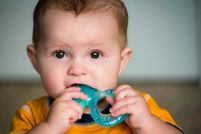
The small piece of tissue that stretches between the upper jaw and lip above the front teeth is called the frenulum. While the thickness and connection point of the frenulum can vary, having a stiff or extended one can prevent free movement of the upper lip. This condition is what’s known as a lip tie and in some cases, can cause feeding challenges in babies.
What Are the Signs of a Lip Tie?
In babies with a lip tie, the upper lip is closely attached to the gum line, which can make it difficult to lift the lip or create a seal with the mouth. This can create nursing challenges and may prevent the baby from gaining weight at a healthy rate. Nursing sessions may also be lengthy and difficult for both the mother and baby.
While the condition doesn’t always impact speech development in children, it could impact their ability to brush the upper teeth, along with the aesthetics of the child’s smile over time. The frenulum tends to decrease in size with age, but it’s impossible to gauge the degree to which it may affect a child in the future.
How Is the Condition Treated?
 Having a closely attached upper lip treated is a simple outpatient procedure which can be performed by a specialty children’s dentist. The procedure is low risk and employs the use of a small, handheld laser to revise the tissue quickly and with precision. Mothers can begin breastfeeding immediately after the procedure. While some babies experience minimal fussiness afterward, direct contact with the mother tends to alleviate any unease.
Having a closely attached upper lip treated is a simple outpatient procedure which can be performed by a specialty children’s dentist. The procedure is low risk and employs the use of a small, handheld laser to revise the tissue quickly and with precision. Mothers can begin breastfeeding immediately after the procedure. While some babies experience minimal fussiness afterward, direct contact with the mother tends to alleviate any unease.
If you suspect your baby could have a lip tie and are exploring your treatment options, contact the experts at Alaska Dentistry for Kids in Anchorage. Specializing in lip and tongue-tie procedures, Dr. Chris Coplin is an experienced children’s dentist who also offers general and preventive treatment for patients, ranging from babies to teenagers. Learn more about their specialty services by visiting their website, or call (907) 274-2525 to schedule an appointment.
About the Business
Have a question? Ask the experts!
Send your question

